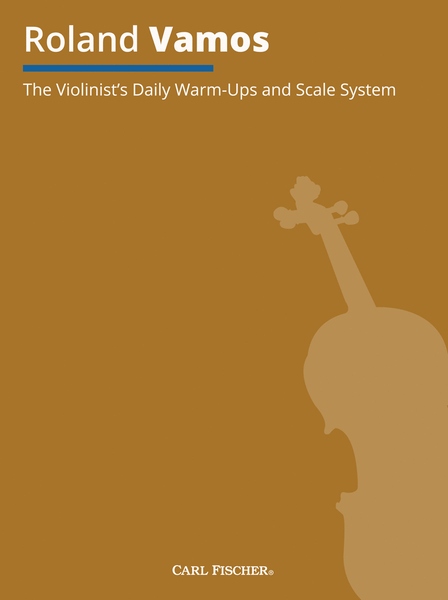The Violinist’s Daily Warm-Ups and Scale System
-
Ships in 1 to 2 weeks
Details
Description
SKU: CF.BF131
Composed by Roland Vamos. With Standard notation. 168 pages. Carl Fischer Music #BF131. Published by Carl Fischer Music (CF.BF131).ISBN 9781491153765. UPC: 680160911264. 9 x 12 inches.
Inspired by Clarence Cameron White’s book The Violinist’s Daily Dozen, The Violinist’s Daily Sixteen is a collection of daily exercises compiled by Roland Vamos. Intended for student and professional violinists, the collection provides the performer with a variety of exercises for daily warm-ups. Mr. Vamos also focuses on developing dexterity and flexibility in the fingers and joints, the first and fourth fingers in particular. Each of the sixteen exercises is notated for each of the four strings, and Vamos recommends that the exercises be practiced as warm-ups, choosing a different string for each day of practice.Also included with the Daily Sixteen is a comprehensive set of studies for developing fluency with scales and arpeggios. Mr. Vamos’ unique methodology is to begin with major scales and arpeggios, followed by minor scales and arpeggios, all of which are notated in two, three and four octaves. Alternate fingers are provided, as well as a variety of slurred and mixed bowings using the three parts of the bow whenever feasible. It is a remarkably systematic approach to performing scales and arpeggios on the violin and will surely benefit students and professionals alike.
ForewordThis short hand-setting set of exercises was inspired by a book entitled The Violinist’s Daily Dozen, conceived by Clarence Cameron White, a prominent African-American violinist, composer and arranger who enjoyed the bulk of his career in the first half of the twentieth century.I have practiced this set of exercises since I was twelve years old. It has served me as a superb warm-up and hand setting tool. Over the years, I have found that there are some aspects of this warm-up routine that were not given sufficient attention or not addressed at all. Consequently, I have expanded the Daily Dozen to create a new work entitled The Violinist’s Daily Sixteen.I have also paid particular attention in this work as to how these exercises are to be practiced. In exercises one and two, I have indicated some notes to be played before the actual written exercises. This is to ensure that the fourth finger will be over the string in a position ready to strike even though it is not being used. Before playing exercises three, four, nine, ten, eleven and twelve, I have indicated silent fingers to be placed on the notes they would be playing if they were being used.I have replaced Mr. White’s grace notes with notes of specific value and have slowed down the exercises so that the first joint (the joint nearest the string) of each finger can move with flexibility and strength. At no time should the first joint buckle.In Mr. White’s version, the last exercise gave the first finger some very valuable backward extensions. In this exercise (number 14 in this book), I caution the student not to move the hand along with the first finger. The hand should remain in position while the first finger independently moves back and forth.It became obvious to me that if the first finger were given the opportunity to develop the dexterity that Mr. White’s twelfth exercise emphasizes, the fourth finger could benefit from an exercise that gives it a forward extension. Consequently, I added another exercise to create a Baker’s Dozen (thirteen).Several years later, I felt that the second and third fingers should also have an exercise to further develop their dexterity…hence exercise fourteen was added to create a “Vamos Dozen.”Because the first finger did not have sufficient practice in the development of the first joint in the original version, I have added two exercises to precede White’s fifth exercise. After re-working and re-numbering these exercises, I have come up with a total of sixteen exercises. It is my suggestion that these be practiced as a warm-up, choosing a different string each day.—Roland VamosEvanston, Illinois 2017 PrefaceScales are a means of teaching a person the fingerboard on his or her instrument. The fingers move across the strings and are required to make shifts, all in highly organized patterns. Scales and arpeggios are the foundation upon which our repertoire is built. Many scale books have been written; each one being organized in its own specific way. The Flesch Scale System has been a standard for many decades. It is very comprehensive and systematic. From the point of view of establishing similar patterns, it has one drawback: it is organized by starting with a major key, followed by its relative minor, going through the circle of fifths. I believe that it is more profitable to do only major scales with their arpeggios first, going up chromatically, and then follow them in a similar way with the minor scales. In using this approach, the similarities in fingerings between the various scales are more apparent. It is also profitable to have alternate fingerings whenever possible. My approach to scales and arpeggios includes a variety of slurred and mixed bowings using the three parts of the bow whenever feasible. These bowings are not all-inclusive. Whenever a particularly awkward bowing pattern is encountered in the repertoire, it can be practiced as an additional bowing variation in the scales and arpeggios. I have chosen to introduce the three and four octave scales by teaching two octave scales across the strings in one position going up chromatically through seven positions; starting on the first, second, third, and finally fourth fingers in major and melodic minor.—Roland VamosEvanston, Illinois 2017.

 Share
Share